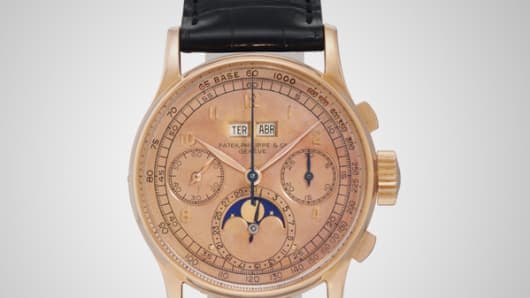Expensive watches seem like a highly effective way of disposing of wealth.
But smart collectors can profit from the rising values of vintage collectible watches – as long as they follow certain rules.
Gordon Bethune is one of the most prominent – and best regarded – watch collectors in America. The former CEO of Continental Airlines, Bethune is selling 50 of his prized watches at auction at Christie's on Friday. The pieces could fetch more than $3 million, with one watch alone selling for up to $1 million or more.
Bethune declines to talk about the appreciation of specific watches. But many of them rose so much in value in recent years that he had to start keeping them in a safe deposit box. In fact, one of the main reasons he's selling them is because they became too valuable to wear.
"I enjoyed them when I bought them 20 years ago and right now the money's just sitting there," he said. "They're sitting in safe deposit boxes. They're wonderful, but you don't wear them because they cost too much money. I want to put the money to use. If I'm not going to wear them, let somebody else wear them and [I'll] do something else with the money."
(Read more: The Millionaires Who Pay the Highest Tax Rate)
Vintage watches have soared in value over the past decade, as the wealthy put more money into collectibles. Auction houses now sell more than $100 million worth of watches a year, and the numbers are growing in the double digits.
Bethune's collection includes pieces from Rolex, Cartier, Patek Philippe and other top names – mainly from the 1930s, '40s and '50s. Many have unusual features, like rectangular faces or rare materials. The centerpiece of his collection being sold is a 1945 Patek Philippe Reference 1518 in 18k pink gold. The estimate is between $600,000 and $900,000, though interest has been so strong that it could break $1 million.
Bethune said that investing in vintage, collectible watches is filled with risks. The market is filled with fake watches, as well as false claims that certain watches will appreciate. But he said you don't have to be rich to be a good watch collector – as long as you follow a few basic rules.
"There's some great watches for $1,500 bucks," he said. "Or you can spend $1,500 bucks and get nothing at a retail store downtown."
He said that one important rule is to stick with the blue-chip names, like Rolex, Patek or Cartier. People should buy from the used market – usually at trade shows or auctions. And he said collectors should pay an expert for advice, given the number of fakes and over-priced models.
"The substitute for knowledge is money," he said. "So pay someone who knows what he's doing to help you. Otherwise you pay too much."
He said the wealthy who spend six-figure sums on watches have a particular passion. (Read more: My Other Yacht Is a Support Yacht)
"Watches are the only jewelry men can wear, unless you're Mr. T," he said. "It's functional, it's a work of art, decorative art actually. They're not just mechanical things. And they're actually reliable, dependable. You can count on them to tell you what time it is."
Of course, a $19 Timex can tell time. But the art – and appreciation – comes at a much higher price.



